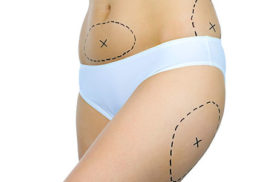
diagnosis of lipedema
A diagnosis of lipedema. aestea clinic is on your side!
We see a recent steady increase in the number of clients turning to us, especially from Germany, but also from other European countries and the world at large with a diagnosis of lipedema. Are you aware of this diagnosis? Perhaps in the description of symptoms you might even see yourself or one of your acquaintances!
This diagnosis is not generally recognized by doctors, or more to the point, by health insurance companies. When we, however, often see a clear irregularity of the physical proportions, namely the slim upper half of the body and the quite inappropriately large lower limbs with visible arching starting from the ankle region, it is not possible to describe this condition merely in terms of poor nutrition and a lack of exercise. Some doctors speak of a “new“ disease for which the term lipedema has been established.
A symptom of this disease is the increase in fat in the areas of the thighs, knees, lower legs, but often also in the areas of the upper arms and forearms. These visible symptoms are accompanied by pain in the affected areas and by the easy formation of bruising.
The cause of this disease is not clear and its sufferers are solely women. There is an obvious genetic disposition and usual progression of the disease.
Three stages of the disease are usually described: from stage I – an increase in the subcutaneous regions into stage II – irregularity of the surface into stage III – fatty lumps and bumps deforming the shape of the limbs.
The recommended conservative approaches – lymphatic drainage, the wearing of compression garments – do not lead to a more significant or long-term solution to the condition.
In our experience, significant benefit, visual effect, and an improvement to the quality of life can only be achieved through large volume liposuction.
Large volume liposuction
In our experience it is possible to remove 10 litres of pure fat by suction in a single operation. Such an operation is only possible under certain conditions.
One fundamental condition is a well-schooled and experienced operating team. Two to three surgeons operate at one time. General anaesthesia is carried out by an experienced anaesthetist who carefully monitors the condition of the patient and her reactions to the procedure being performed, replaces lost liquids, and prevents cooling of the patient. The safety and minimizing of any risks to the patients is of the utmost importance to all involved. For older patients or more seriously ill applicants we recommend a series of smaller operations rather than a single extensive one.
Postoperative monitoring and care
Large volume liposuction is not an insignificant procedure, indeed it is a significant operation and so the postoperative monitoring and care must be appropriate to it. We make every effort to ensure the maximum comfort possible for our clients. Already during the operation preventive medicine is administered against nausea.
Which technique is used for liposuction?
Dr. Šíma: The clinic aestea uses the so-called super-wet technique, where the same fluid is used for infiltration as by the tumescent technique, yet in a smaller amount - the amount of the infiltrated fluid is about the same as of the fat extracted during surgery.
Is there a weight limit for surgery?
Dr. Polanka: We often operate patients who weigh over 100 kg, yet the maximum weight is 120 kg.Does the operation guarantee a complete removal of the disease?
Dr. Šíma: A lipedema liposuction represents by no means a precautionary measure, and does not result in a complete removal of the disease. Nevertheless, we see a significant improvement in the prognosis of all operated patients.
Is it possible to operate the upper and lower limbs at once?
Dr. Šíma: We usually do not recommend such a combined operation. An operation in the calf, knee and thigh area represents a great burden in itself, and the maximum amount of fat which may be extracted is often already reached during this operation.
When can I go back to work after surgery?
Dr. Polanka: It depends greatly on the operation volume, i.e. how many liters we suck out, but also, it partially depends on you, how sensitive, strong and resistant you are, how much you can bear, and, not least on the kind of work you do. We recommend taking vacation for 1-2 weeks. After 2-3 weeks it is usually possible to return to a normal life.
Are artificial nails any problem by the surgery?
An important sensor for measuring blood oxygenation and heart activity is placed on the fingers. Dark and deep nail colors prevent this sensor from working. For this reason, it is necessary that there is no polish on at least the left thumb and left toe. Correct sensor operation is essential for proper course of the operation.

